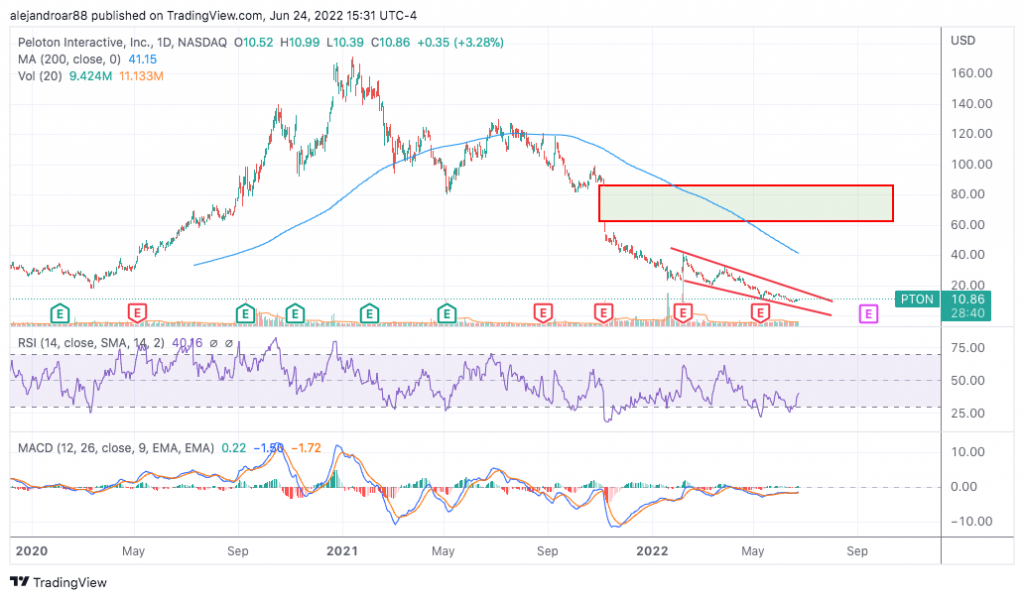Peloton Stock 22% Down in June – Time to Buy PTON Stock?
Please note that we are not authorised to provide any investment advice. The content on this page is for information purposes only.
The price of Peloton stock is down 22% so far this month as the latest actions from the Federal Reserve including a 75bps rate hike implemented only a week ago have continued to weigh on the valuation of companies of all sizes and sectors.
However, for Peloton, the impact of such a measure is perhaps worst than for other businesses as the company has also been struggling with issues related to its pricing, production costs, and user base growth.
In addition, the company’s Chief Financial Officer Jill Woodworth resigned earlier this month after nearly four years with the company.
Also read: Best S&P 500 Stocks to Buy Now in 2022
At a point when investors are focusing a lot on companies with strong fundamentals, solid cash-flow generation capacity, capable leadership, and well-positioned products, Peloton does not appear to stand out in any of those areas.
Therefore, at this point, the most important question is not if the company will manage to grow again but, instead, if it can survive a recession in the United States.
In this article, I’ll be taking a closer look at the price action and fundamentals of Peloton stock to outline plausible scenarios for the future.
Peloton Stock – Technical Analysis

Peloton’s pains did not start this year. They go back way before to the beginning of 2021 when supply chain constraints started to affect the company’s gross margins. At the same time, investors started to worry that en-masse vaccinations and easing social distancing protocols will lead to people going out more, meaning less demand for in-house products such as Peloton bikes.
Moreover, the company’s struggles became clear when its Chief Executive Officer, John Foley, stepped down at the same time Peloton announced it was laying off 2,800 people as part of a program to reduce expenditures by around $800 million per year and capital expenditures by $150 million.
Even though investors initially reacted positively to the news as reflected by two consecutive 20%+ single-day jumps in the stock price, PTON stock continued to head downwards shortly afterward as negative sentiment across the market did not ease.
As of today, Peloton stock is down nearly 70% so far this year while it is trading almost 94% below its all-time high of $172 per share booked on January 2021.
Also read: Investing in Stocks Explained
In addition, the stock is positioned 74% below its 200-day simple moving average, which emphasizes a significant lack of confidence from investors in regards to the company’s mid-term prospects.
Momentum indicators at the moment are not necessarily bad as the Relative Strength Index (RSI) did not make a lower low despite the price diving to all-time lows recently and the same goes for the MACD.
However, unless the $20 level is crossed, the downtrend remains in play for Peloton stock and that means the baseline scenario in the short-term is bearish for this tech stock.
Peloton Stock – Fundamental Analysis
From a fundamental perspective, Peloton is no longer the promising growth story it once was or at least not for now as it has a lot to take care of going from its manufacturing capacity to its pricing and margins.
The most important thing for the company at the moment is to cut costs by trimming their operating expenses so it can work its way through these challenges.
In addition, it has to keep its cash burn under control or better – become a cash-flow positive enterprise.
In the first nine months of its 2022 fiscal, which ended on 31 March, the company burned $1.68 billion in cash and spent another $243 million in capital expenditures. In addition, it had $1.4 billion in inventories.
Bike sales plummeted to $1.89 billion during that same period compared to $2.49 billion the firm sold in the first nine months of the 2021 fiscal year while gross margins declined 1,380 basis points to 25%.
By the end of that period, the company had cash reserves of $880 million, which may suffice for just two quarters if the firm’s cash burn remains unchanged. However, Peloton secured a $750 million lifeline from JPMorgan Chase Bank and a $500 million revolving credit facility.
The company must maintain a minimum level of liquidity of $250 million as part of the terms and conditions of the loan and it must also keep its last-12-month sales above $3 billion.
The applicable interest rate may be in the double-digit area based on the prevailing prime rate and the extra interest contemplated in the agreement. Approximately, the effective rate paid per year for this loan should be around 10% to 14%.
This means that Peloton will pay an additional $50 to $70 million in interest expenditures over the next 12 months.
The current CEO of the company has assured investors that the business will not need to sell shares at these current depressed levels to remain afloat as liquid reserves should suffice for now.
However, if sales do not improve and the company fails at turning around the downtrend in its profit margins, those reserves will not be enough to keep the company from going bankrupt a year or so from now.
There’s a silver lining to the situation and that is the possibility that Peloton may be acquired by a third party who would like to enter the at-home fitness space. However, how much such a company will be willing to pay for a business with so many challenges to overcome is unclear and the current $3.65 billion price tag is not necessarily screaming bargain.
Other Related Articles:






